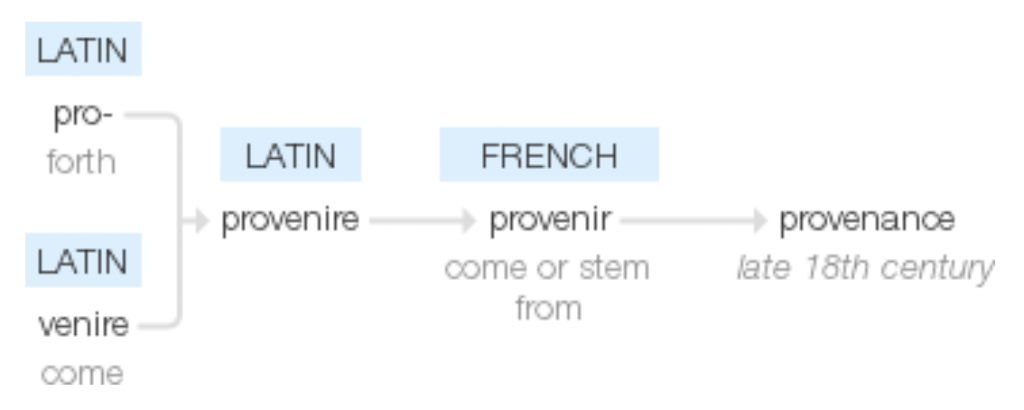Provenance is an important aspect of any business that involves supply chain. What is provenance and how distributed ledger technology can add value here?
First of all, let’s do away with definition. According to Oxford Dictionary:
provenance
/ˈprɒv(ə)nəns/noun
the place of origin or earliest known history of something.”an orange rug of Iranian provenance”synonyms:origin, source, place of origin;
the beginning of something’s existence; something’s origin.”they try to understand the whole universe, its provenance and fate”
a record of ownership of a work of art or an antique, used as a guide to authenticity or quality.plural noun: provenances “the manuscript has a distinguished provenance”

Etymology of “provenance” tells us it originates from Latin pro meaning “forth” and venire meaning “come”. Simply put, it’s about where something comes from.
Reliable tracking of origin becomes increasingly important in supply chains nowadays. From one side, growth of population and its demands, globalisation and industrialisation, mass production, constant drive to reduce costs result in complex relationship where it is easy to lose track of the origin of a good or service. From the other side, lately consumer awareness has been pushing back against this trend. Supermarkets in UK, for example, now clearly display whether this bag of potatoes is produced in a local farm, this pack of lamb chops comes from New Zealand, tomatoes from Spain and sharon fruit from Israel. You also get a choice of standard milk vs “organic” one, eggs from caged hen vs free range, standard tea and fruits vs “fair trade”. Consumers in London or a small trendy grocery shop in San Francisco often are happy to pay more when they know their purchase (a) supports local produce such as a family ran farm; or (b) comes from a country far away but with a guarantee that producers are treated fairly and not abused by large monopolist buyers. Indeed increasingly there is more awareness that cheap clothes come at a cost of being made in a “sweatshop” where workers work abnormally long hours in unconditioned and crowded premises , they are underpaid, overworked and sometimes even child labour or slave labour could be used. “Blood diamonds” is one of the extreme examples where something expensive, noble and fashionable might have quite a horrible background story. According to Forbes, De Beers and Fura Gems are addressing this problem with a blockchain powered tracking solution.
Is enough being done? Well arguably not. As the diamonds example shows us despite intergovernmental initiatives and regulations such as Kimberley Process the problem is still there due to fraud, falsification, lack of technology or costly implementation. Similarly when you purchase a fruit or a t-shirt you will get some general information about where it’s coming from, but it remains very general and there is no way for you to verify that. It is a matter of blind trust.
How distributed ledger technology (DLT) and blockchain can help?
In August 2018 we have published a Medium report on state of the market of blockchain technology in logistics and supply chain. At that point at least 21 global projects, initiatives and partnerships have been announced including IBM – Walmart initiative in China where blockchain technology is used to track food from supplier to shelf. More details in Forbes publication here. Last month at Dubai Blockchain Summit I had a pleasure of attending presentation by Anthony Butler, CTO of Blockchain Services IBM where he has gone through some of the case studies including Walmart case.

According to presentation, the solution has solved the problem of digitally tracing food products by providing a “permanent record of food supply chain transactions including a product’s origin details, processing data, and shipping details that are digitally connected to food items”.
IBM claims 99% decrease in time to track food from store to source and $700B savings in US alone with a 1% reduction in food borne illness.

Specifically around Provenance, the following achievements are mentioned:
- Reduced traceability time from days to seconds
- Reduce fraud
- Faster recalls
- Improved transparency
- Protect brand value
- Increased regulatory compliance
Distributed ledger technology helps with provenance as it promotes “verifiable trust” by allowing all participants independent and direct access to full ledger, full data history from day 1 to now, from source to shelf. Additionally, as we know blockchain records are tamper-resistant meaning a hacker or participating business will find it extremely difficult to modify any historical records without alarming participants of the network.
Practical example: “TracyChain”
At Dappros we are building a platform that allows enterprises leverage the distributed ledger or blockchain technology. One of our products is “TracyChain” which addresses logistics and supply chain use cases including provenance. TracyChain actually is a good example allowing us to look into how this is typically implemented so let me use it as a practical example:

Screenshot above is from our interactive demo currently available online at http://tracychain.com/demo. It illustrates an imaginary scenario of shipping cheesecakes from a factory in Boston to a warehouse in Bridgeport to final destination a retail shop or cafe in New York.
1. As soon as an item is produced we create an Asset entity which is recorded both in centralized database (such as MySQL or MongoDB) and on blockchain. In this demo we use a private Ethereum blockchain.
2. As any supply chain update is available, we create a Trace which is simply a record. This may be an update of GPS location or data from IoT device such as temperature sensor placed inside a refrigerated container. Each record always refers to specific Asset or Shipment ID, stores current timestamp in milliseconds and can store other custom parameters.
3. Only difference from conventional systems is that trace records are created on the blockchain. Once they become ‘mined’ into a block and verified by nodes of the network these records become tamper proof and instantly available for informational or audit purposes to any participant of the network.
4. Trace records benefit from the concept of cryptographic keys and crypto wallets which are core to Ethereum blockchain. Each Trace record shall be signed at least by one ‘wallet’ in the system which typically represents a role (for example a supplier or a warehouse operator). Wallets/key-pairs could also be held by devices and robots, so for example QR bar scanner or smart thermometer can create and sign their own Trace records relevant to specific shipment. This way the provenance record gets updated independently by multiple agents into a shared blockchain ‘database’ without risk of this data taken down or modified by malicious agent.
5. Additionally, multi-signature concept could be used where applicable. E.g. shipment arrives by truck from Boston to a warehouse in Bridgeport. Truck driver scans shipment QR code using their smartphone app which creates a record signed with delivery driver’s key pair. Warehouse operator confirms they have accepted the shipment into storage by scanning QR code and co-signing the record with their key pair or creating a new record to a similar effect.
6. All Trace records become immediately and permanently available on the blockchain. Additionally, in case of TracyChain system all data is available via API which makes it easy to connect with ERP and other legacy systems.
7. Data updates, consumption and storage are all decentralized which creates “trustless” environment meaning a single participant doesn’t have to worry about data and systems being controlled by their counterparts. Everybody gets access to same ground truth data and full ledger of records from day 1 with full transparency and traceability of who has created each record and when.
As shown above, distributed ledger could be a good solution for setting up a shared ‘trustless’ data storage for provenance and other logistical purposes where data becomes tamper proof and easily available to all participants of the supply chain process.
Of course blockchain technology cannot solve provenance on its own. Usual processes and safeguards such as multi-signature confirmation shall be applied to ensure that correct data is recorded into blockchain in the first place. Decentralized applications shall be fully integrated with existing ERP systems, warehouse & supply chain management solutions, IoT smart tracker hardware systems. Processes, operations, legal framework and conventional technology shall envelop this innovative blockchain powered addition for it to be fully practical and effective.
Moreover, real-world applications often introduce very challenging obstacles that require creative solutions or workarounds. I’ve had an interesting discussion recently with potential customers around use case which involves shipping millions of fertiliser bags to farmers. It turns out as packaging and contents are very cheap, there is literally no way to add individual package tracking. We aren’t talking about GPS sensor, even QR or bar code cannot be added to the package in the scenario discussed. This means we cannot track each individual package in such scenario and shall do it at container or some other level, unless some work around or cost effective solution is found.
To summarize:
- blockchain technologies are increasingly widely applied to improve provenance;
- information lookup time gets reduced from days to seconds;
- more information is going to be available for supply chain participants and end customers – which might include point of origin data, GPS tracking, temperature regime, photos, certificates etc. Technology is already there to make it instantly accessible upon scanning a QR code;
- blockchain technology and its integrations are in its infancy; most of implementations haven’t reached beyond Proof of Concept stage yet; numerous obstacles need to be overcome such as getting industry players to work together using same tech and standards, integrating with legacy systems, overcoming use case specific real-world challenges.

